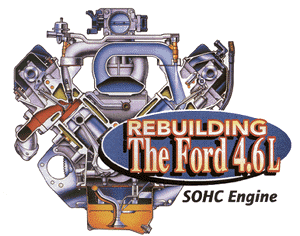
Rebuilding the Ford 4.6L SOHC Engine
by Doug AndersonContributing Editor
danderson@engine-builder.com
The 4.6L Romeo SOHC was introduced in 1991 as the first born in an all new family of engines for Ford. It had a rigid, deep-skirted block with cross-bolted mains, long rods that gave it a favorable rod length-to-stroke ratio, a lightweight crank and pistons, and SOHC aluminum heads that incorporated all the latest engineering theory with ports and chambers that were designed to make more power with fewer emissions.
The 4.6L was lower, shorter and lighter than the 302, but the base engine made more power than the 302, got better fuel economy and passed all the emission tests without a thermactor pump. Ford called it its "modular" engine because it was part of a whole new family of engines that were intended to have a common architecture "so they could share similar production tooling and have many interchangeable parts."
The V6 that was originally intended to be part of the modular program never did get built, but there are several engines in the V8 family, including one 4.6L DOHC and two SOHC motors, along with the 5.4L V8 and the 6.8L V10 that are all part of this "modular" family.
Although the idea of a standardized, modular engine looked good on paper, it hasn’t worked out quite as well in the real world, because there have been many changes that have created lots of variations over the last 10 years.
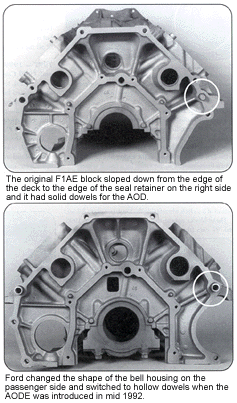
The 4.6L engines built in the Windsor plant are completely different than the ones built in the Romeo plant, and there are significant differences in the engines that have been built in each plant from year-to-year, so there are at least eight short blocks, seven heads and 13 long blocks so far, not counting the CNG and DOHC engines.
It’s pretty confusing to keep track of all the different combinations, so nobody seems to know what goes where or exactly when it was used. We tried to get some help from Ford, but we were unable to find anyone who was willing to share any information, so everything in this article is based solely on what we have seen and pieced together along with the help of some other people in the industry.
We believe that what we have figured out so far is pretty accurate, but we know there’s more to the story because we learn something new on a regular basis, so start with what’s here and build on it with your own experience.
With that disclaimer in mind, let’s take a look at the 4.6L SOHC modular engine and walk it through, year-by-year, beginning with the blocks, and see what Ford has done with these engines from 1991 through 1999, keeping in mind that the CNG and DOHC applications aren’t included in this discussion.

Blocks
There have been two distinctly different cast iron blocks used for the 4.6L, depending on whether the engine was built at the Romeo plant or the Windsor plant. There are two Windsor blocks with two casting numbers and one minor difference, and there are four different versions of the Romeo block with several different casting numbers.
1991 – 1992 Romeo
The original Romeo block was a F1AE casting that can be identified by the solid dowels that were used for the automatic overdrive (AOD) transmission, along with the shape of the bellhousing that slopes down from the deck to the edge of the rear seal retainer at about a 30 degree angle on the passenger side. The first four mains are cross-bolted with "jackscrews" between the block and the main caps, but the rear main isn’t cross-bolted. This block was used through 11/1/91 in the Lincoln Town Car and through 2/18/92 for the rest of the Ford and Mercury cars that came with the 4.6L engine.
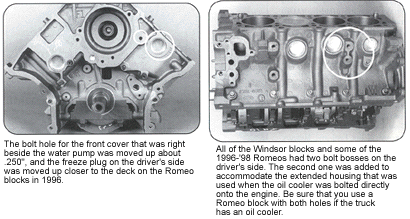
1992 – 1995 Romeo
The F2VE block replaced the original casting when the AODE (automatic overdrive, electronic) transmission was introduced late 1991 or early ’92 in the RWD Ford and Lincoln/Mercury cars (See the dates in the above paragraph). It was superseded by the F4VE casting that was identical to the F2VE in 1994. These blocks can be recognized by the hollow dowels that were used along with the AODE (automatic overdrive electronic) transmission and the semi-circular boss for the starter that was added on the right side of the bell housing
The corner of the block is reinforced by a triangular web that is parallel to the pan rail and perpendicular to the front of the bell housing, too. And, these blocks still have only four cross-bolted mains instead of five like all the later Romeo blocks.
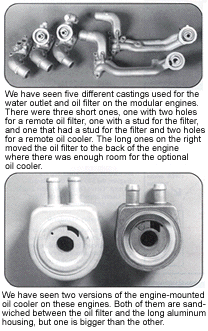
1996 – 1998 Romeo Car
The third Romeo block was introduced in 1996. There have been three different casting numbers including the F65E-CC, F6VE and F7VE, but all three blocks are the same. These blocks have five cross-bolted mains instead of the four that were found on the earlier blocks, and they have a threaded hole in the valley for a knock sensor.
The freeze plug on the driver’s side was moved up closer to the deck and the bolt for the front cover that’s right beside the bi
g hole for the water pump was moved up about .250˝ closer to the deck, so it’s located at 2 o’clock instead of 3 o’clock when facing the block (see photo below).These blocks appear to have been used for the 1996 and ’97 cars (the "V" in the casting number indicates that the casting was originally designed for a Lincoln) and the 1997 pickups that were built in 1996 and titled as ’97s (the "5" in the casting number indicates that it was intended for the pickups).
This block will work in all of the RWD cars including the Fords, Lincolns and Mercurys, and in some of the trucks, too, but it won’t work in all of the trucks because it doesn’t have the extra bolt hole between the second and third soft plug on the driver’s side that’s used for the oil cooler that was included with the optional trailer towing package on the trucks.
By the way, there are some Crown Victorias with the Police Interceptor package that have an oil cooler, too, but it’s mounted under the radiator, so this block should fit all the cars up through 1998 or ’99.

1997 – 1999 Romeo Trucks, Vans, Expeditions and 1999 Cars
According to the F7AE casting number, this block was designed for a 1997 car, so it probably was used in some cars along with the F7VE block, but we believe that it was the primary block for the 1997–’98 pickups, vans and Expeditions until it was replaced by the XW7E casting in 1999.
Both of these castings, the F7AE and XW7E, have a second bolt hole under the existing one between the second and third soft plug on the driver’s side. Both of these holes were used to mount the extended housing that moved the oil filter to the back, closer to the bell housing, so there was enough room for the oil cooler that was part of the optional trailer-tow package on the trucks and Expeditions.
Since most of them came without the trailer-tow package, and it seems unlikely that Ford would have had the same engine with two different castings waiting on the assembly line, we believe that the F7AE block was used in most of the pickups, vans and Expeditions through 1998 until it was replaced by the XW7E casting in 1999.
1996 – 1999 Windsor
The F65E-BB and F75E castings are the only Windsor blocks that have been used through 1999. Don’t confuse the F65E-BB casting with the F65E-CC Romeo block that’s completely different.
All five main caps on the Windsors are crossbolted, but they have dowels between main caps and block instead of the jackscrews that were used for the Romeo blocks. All of the Windsor blocks have the second hole on the driver’s side for the extended housing that moved the filter to the back of the engine and they all have a threaded boss in the valley that was used for the knock sensor or a bracket, but the hole may be either 8.0 mm or 12.0 mm, depending on the year.
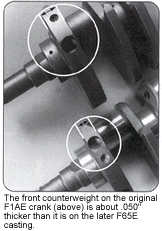
All of the F65E-BB blocks and some of the F75E blocks had a 12.0 mm hole, but some of the F75E castings had the smaller 8.0 mm hole. The parts book says that most of the trucks had a knock sensor in 1997 and ’98, so they needed the bigger hole, but some applications came without it and used a special stud and nut to hold the water pipe that laid in the valley. We have seen a F75E block with PI (Power Improved) heads on it with an 8.0 mm hole, so we know that the hole size was changed by 1999. However, it could have been changed earlier, too, but our best guess is that the 1997s and ’98s had the 12.0 mm hole and the 1999s had the 8.0 mm hole.
The bolt pattern for the front cover is the same as it is on the late Romeo blocks, but the two bolt holes just above the pan rail are 10 x 1.50 mm instead of 8 x 1.25 mm.
Most of the Windsor blocks we have seen have the letter "W" cast somewhere on the block, on the front, on the back, in the valley, and sometimes even on the sides, too, so they’re usually pretty easy to spot.
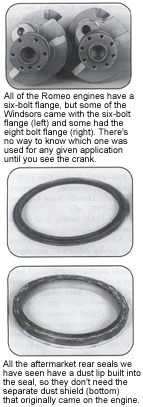
Cranks
There have been two different castings used to make three different cranks for the 4.6L SOHC engines.
1991 – 1995 Romeo
The original crank used in the Romeo engines was an F1AE casting. It was a nodular iron crank that had six, knife-edged counterweights an
1996 – 1999 Romeo
The F65E casting was used from 1996 through ’99. It looked like the original crank and it still had a six-bolt flange, but the front counterweight measured from .920˝ to .940˝ wide, so it was about .050˝ narrower than the earlier casting.
1997 – 1999 Windsor
All of the Windsor motors came with the F65E crank. Some had the six-bolt flange and some came with an eight-bolt flange, but there’s no sure way to know which one was used for any given application, so it can be a real problem for rebuilders.

It appears that most of the Windsors used the eight-bolt crank, but there are definitely some of them out there with six-bolt cranks, so check with the customer before selling an engine or a crank.
All of the Windsor engines that have the six-bolt crank must be built with the F65E casting that has the narrow front counterweight because there are two machined pads on the back side of the front main that stick out far enough to hit the thick counterweight on the F1AE crank.
Rods
All of the 4.6L rods are made of powdered metal and come with cracked caps, but they’re not all the same. The rods used in the Romeo engines were designed for press-fit pins while the ones in the Windsors were all bushed for full-floating pins. (photo, top of page 36).
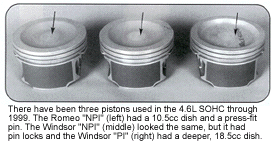
None of these connecting rods come with any casting numbers, but you can sometimes make out the identification numbers that were printed on the shank of the connecting rods; we have seen F1AE and F2AE numbers, but there are probably several others that we haven’t noticed.
Pistons
There have been three different pistons used for the 4.6L through 1999, one for the Romeos and two for the Windsors.

1991–1999 Romeo
The Romeo engines all used the same piston from 1991 through ’99. It had a small
1996–1999 Windsor With NPI Heads
The original piston for the Windsors had a small (10.5 cc) dish and a 1.5 mm/
1999 Windsor with PI Heads
The Windsor pistons were changed in 1999 when the "power improved" (PI) heads with the square intake ports and smaller heart-shaped chambers were introduced. The size of the bowl was increased from 10.5 cc to 18.5 cc to make up for the difference in the chamber size and still maintain the same compression ratio. This piston still had the 1.5 mm/1.5 mm/3.0 mm ring pack with the shallow top groove and circlips to hold the pin in place.
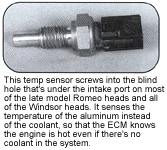
Cylinder Heads
Ford has used several different heads on these engines. We have identified five different ones for the Romeos and two for the Windsors through 1999. They all seem to fit into the following pattern:
1991–1992 Romeo
The Romeo engine used the F1AE casting in 1991 and part of ’92. It appears that the heads were changed at the same time the block was changed, so this head was probably used through 11/1/91 on the Lincoln Town Cars and through 2/18/92 on the rest of the Ford and Mercury cars.
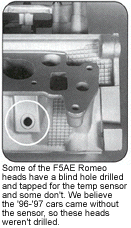
It has two "ladder style" cam caps, nine bolt holes for the rocker cover and it’s threaded for long reach spark plugs most of the time. However, there are some F1AE castings that are threaded for the later short reach plugs, so be sure to check the threads before using this casting.
1992-1995 Romeo (1992-’94 all, 1995 T-Bird/Cougar)
The F2AE/F4AE head replaced the original Romeo head in mid-1992, but there are some F1AE castings that are threaded for the short reach plugs, so they can be used for these app
1995–1997 Romeo Car (1995 Crown Victoria, Mercury Marquis, Lincoln Town Car and 1996–1997 all)
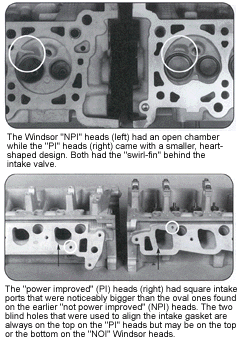 The F5AE casting that had a revised combustion chamber with a "swirl fin" (eyebrow) behind the intake valve was introduced in some models in 1995. These heads also had an additional boss for a temp sensor that was located under the front intake port on the driver’s side, but it wasn’t always drilled because the cars didn’t use this sensor until 1998.
The F5AE casting that had a revised combustion chamber with a "swirl fin" (eyebrow) behind the intake valve was introduced in some models in 1995. These heads also had an additional boss for a temp sensor that was located under the front intake port on the driver’s side, but it wasn’t always drilled because the cars didn’t use this sensor until 1998.
These heads could be converted for use on the trucks by drilling and tapping the blind hole and spot facing the boss for the sensor, but it takes a milling machine and a fair amount of time to do it right, so it’s probably easier to catalog them separately and use the castings that aren’t drilled on the cars that came without the sensor.
1996–1999 Romeo Truck and 1998–1999 Romeo Car
The F5AE castings that had the hole for the temp sensor drilled and tapped were used on all the 1996-’99 trucks and the 1998-’99 cars. This sensor is installed in a blind hole that doesn’t go to coolant because it is designed to sense the temperature of the aluminum itself as a backup in case the coolant level is too low to register on the coolant sensor.
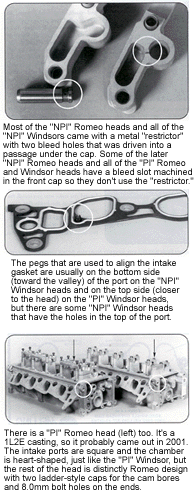
1996–1999 Windsor "NPI"
The F65E/F75 and F75E castings were all used on the Windsors from 1996 through ’99. They had individual caps on each cam journal, 12 bolts instead of nine around the perimeter of the head for the cam cover, and the four bolt holes on both ends were 10 x 1.50 mm instead of 8 x 1.25 mm like they were on all the Romeo heads.
The combustion chambers on these heads had the "swirl-fin" behind the intake valves and they had small, oval intake ports, so they’re called "not power improved" (NPI) heads to differentiate them from the later design that’s known as the "power improved" (PI) head. The "NPI" heads were used on all Windsors up through 1998 and for some applications in 1999, so be sure to verify the casting number before deciding which one to install on one of these later engines.
Most of the F65E/F75/F75E castings have a small, round, machined "restrictor" driven into the head right under the wide cam cap, but we have seen a F65E with a machined slot in the cap and no "restrictor" in the head. The hole in the heads that have the slotted cap is too small for the "restrictor," so it’s not a problem as long as you know what you’re looking for and you make sure you install the "restrictor" in the heads that came with it.
Rebuilders may have one problem with the "NPI" Windsor heads; the two blind holes that are used for the pegs that hold the intake gasket in place during assembly are on the bottom (toward the valley-side) of the intake ports most of the time. But, there are some F75E castings that have the holes at the top side of the ports (near the head). They were on the bottom on the F75E casting when it was used on the 4.6L from 1996-’99 and on the 5.4L in 1997.
They were on the top of the F75E castings when they were used on the 5.4Ls in 1998 and ’99, and they’re on the top of all the service replacement heads that are sold now. Rebuilders need to send the matching intake set with a Windsor engine when they sell one with "NPI" heads.
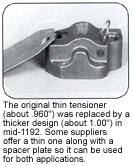
1999 Windsor "PI" Heads
The "power improved" (PI) casting (XL3E) with the square intake ports was introduced in 1999. It has bigger intake valves, different springs, and a small, heart-shaped chamber that has a swirl-fin behind the intake valve. These heads don’t have the "restrictor" that’s driven into the head, so the wide cap has the small slot machined in the divider between the two sides.
The "PI" heads weren’t installed on everything in 1999, and the parts books aren’t clear about exactly where they were used, so there’s a lot of confusion about which applications came with or without them.
In fact, no one seems to know anything for sure, except that: 1) all the Mustangs had "PI" heads in 1999; and 2) some of the trucks and Expeditions had them in 1999. Our best guess is that all the Expeditions got them, along with some of the F250 pickups, but they definitely weren’t used on all of the pickups in 1999, so be sure to ask for the casting number before you sell an engine or a head.
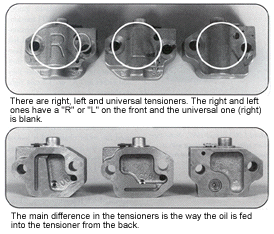
2001–2002 Romeo
Even though we’re not talking about anything beyond 1999, you should be aware that there is a Romeo "PI" casting out there, too. The 1L2E casting has ladder caps, small bolt holes in both ends and nine bolt holes for the cam cover along with the square intake ports and the small heart-shaped chambers.
This casting number is for a 2001 Explorer, so the "PI" head probably wasn’t used on Romeo engines until then. But, it’s possible that there were some earlier applications in spite of the casting number, so keep an eye out for them when you get a late model Romeo core.
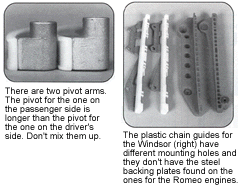
Timing Components
There have been four different timing sets used on the modular motors, three on the Romeos and one on the Windsors.
1990-1992-1/2 Romeo
The original timing set used on the Romeo motors had a roller chain, steel-backed, plastic guides and the thin (about .960˝) tensioners along with right and left tensioner arms. There were right and left tensioners with different oil passages on the back
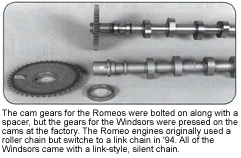
1992-1/2 -1993 Romeo
The second Romeo timing set still used the roller chain and it looked the same, but it was slightly different because the mounting pad on
1994–1999 Romeo
The third timing set for the Romeo motors had a link-style, silent timing chain instead of the roller chain, so it had different sprockets, but everything else stayed the same.
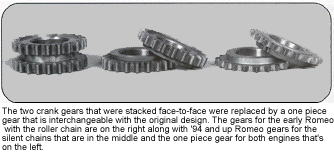
1996–1999 Windsor
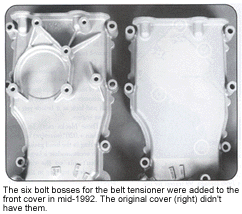 The tensioners and pivot arms on the Windsors are the same ones that were used on the later Romeo engines, but the guides are made of plastic with no steel backing and some of the mounting holes were moved, so they’re completely different. All the Windsors had the link-type, silent timing chain and gears.
The tensioners and pivot arms on the Windsors are the same ones that were used on the later Romeo engines, but the guides are made of plastic with no steel backing and some of the mounting holes were moved, so they’re completely different. All the Windsors had the link-type, silent timing chain and gears.
Cams
The cams for the 4.6L engines can be pretty confusing. They’re all hollow designs with pressed-on lobes, but that’s where the similarity ends, because there are right and left cams that came with and without the gears and there are several different profiles to consider.
The cam chart (below) is our best take on it with the help of Milt Olson from Engine Power Components. We’ve also seen three other cams that we haven’t been able to identify by application (F1AE-6250-BD/F65E-6250-AA/F1AE-6A274-BD), so we aren’t using them in anything at this point. The rest of them appear to be interchangeable as shown on the chart, but that’s just an opinion, so let your conscience be your guide when consolidating cams for these engines.

Front Covers
There have been several front covers used on these engines, depending on both the year and the application. The chart (below) provides a good overview, but there are a few things worth noting:
1990 to 1992-1/2 Romeo
The F1AE/F2AE front covers had 15 small holes (8.0 mm) around the perimeter and no bosses for the tensioner.
1992-1/2 to 1995 Romeo
The F3AE/F5AE covers still had the small (8.0 mm) holes, but they also had six cast bosses on the passenger side that were used to mount the tensioner and idler for the serpentine belt.
1996-1999 Romeo and Windsor Car (except 1999 Mustang)
The front cover for the car was changed in 1996 when the Windsor motor was introduced. The six bosses for the tensioner were the same, but the bolt hole by the water pump was moved up about .250˝ and 10 of the holes were opened up to 10.0 mm to accommodate the larger bolts that were used for some of the holes on the Windsors.
The F6AE/F7AE/F7ZE/F8ZE castings were used on all the cars from 1996 through ’99, except for the Mustang that had its own unique front cover in 1999.
1996 – ’99 Truck, Van and Expedition (except ’99 Econoline)
All of the trucks, Expeditions and vans (except the 1999 Econoline) shared a common front cover. The F65E casting had 10 large 10.0 mm bolt holes and five, small 8.0 mm holes along with six bolt bosses for the tensioner. However, the bosses for the tensioner were arranged in a different pattern that was unique to the trucks, so the car and truck covers can’t be interchanged.
1999 Mustang
The front cover on the 1999 Mustang was an XR3E casting. It had four bosses for the tensioner and a machined pad for the idler further down on the passenger side of the cover.
1999 Econoline
The 1999 Econoline had its own special 2L3E front cover. It looked the same as the earlier F65E truck casting, but the 30° timing pointer was no longer cast on the cover.

That pretty well covers all the major components for the 4.6L Ford engines, but that’s not all there is to the story. There are a few other things every professional rebuilder should know about these engines before starting to rebuild them.
Rebuilding Tips
- Ford recommends torque-plate honing all the 4.6L blocks.
- Ford recommends replacing the head bolts every time the heads are removed from the engine.
- There is no way to know whether a Windsor motor came with a six-bolt or eight-bolt crank until it’s out of the vehicle, no matter what the customer says, so make him take it out and look at it before you ship him an engine.
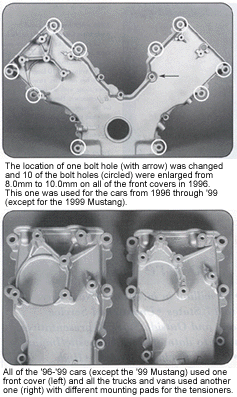
- You can’t recondition the rods by cutting the caps because of the cracked cap, but there are oversize rod bearings available in the aftermarket that work fine.
- We have seen several of the left hand cam sprockets for the Romeo motors that have the tab that indexes in the keyway completely sheared off. Check both the cams and the gears carefully before reusing them.
- There are reports that there were some oversize rods in new engines, so double-check them, especially if you’re not using oversize rod bearings.
- These engines appear to be very prone to detonation. We have seen several pistons with rod bearings that have been pounded to death from abnormal combustion. Some of the Romeo engines that are used in police cars and limos appear to have serious detonation problems, so watch out for comebacks with these applications.
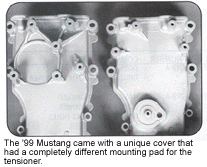
That’s what we know about the 4.6L Ford. Start here and build on this information with your own experience and you’ll be ahead of the game. There are thousands of these engines out there and they’re not all going the miles, so there should be plenty of opportunities for everyone in the industry to build a bunch of them.
Editor’s Note: This article would not have been possible without the help of many other people in the industry who shared their knowledge and experience. A special thanks to Roy Berndt at the Production Engine Remanufacturers Association (PERA), Milt Olson from Engine Power Components and the people at Mahle for all their help.
Doug Anderson is vice president of Grooms Engines, Parts, Machining, Inc., a production engine remanufacturer in Nashville, TN.
